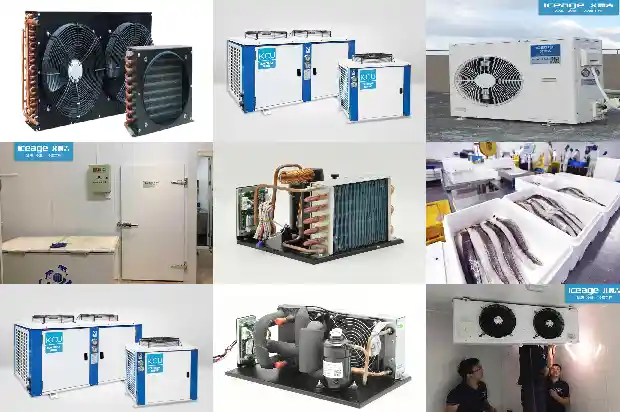How to Install and Maintain the Units Inside the Cold Storage?
2024-11-19
Installation of the indoor units in the cold storage:
Steps: Determine the location of the indoor units → Mark the position with lines → Use a hole expander to enlarge the holes → Fix the support rods on the roof of the cold storage → Connect the hanging bolts of the units → Fix the indoor units.
Steps: Determine the location of the indoor units → Mark the position with lines → Use a hole expander to enlarge the holes → Fix the support rods on the roof of the cold storage → Connect the hanging bolts of the units → Fix the indoor units.
Refrigerant piping:
(1) Steps: For the cold storage project, carry out piping according to the requirements of the drawings → Lay the pipelines → Weld → Purge → Leak test → Dry → Insulate.
(2) For the cold storage project, in principle, the refrigerant piping should strictly adhere to the three principles of piping: dryness, cleanliness, and airtightness.
Regarding dryness, first of all, moisture is prohibited from entering the copper pipes before installation. Secondly, after piping, the pipes should be purged and vacuum-dried. Cleanliness means that attention should be paid to the cleaning inside the pipes during construction. Moreover, nitrogen replacement welding should be adopted during welding, and finally, the pipes should be purged. For the airtightness test, on the one hand, the welding quality and the connection quality of the flare joints should be ensured, and on the other hand, the final airtightness test should be carried out.
(3) Method of replacing nitrogen in the cold storage project:
During brazing of the refrigerant pipes in the cold storage project, nitrogen protection must be adopted. During welding, a slight pressure (3 - 5 kg/cm2) of nitrogen should be filled into the pipes being welded, which will effectively prevent the formation of oxide scale inside the pipes.
(4) Covering of the refrigerant pipes in the cold storage project: Covering the refrigerant pipes is very important. It is necessary to prevent moisture, dirt, dust, etc.
(1) Steps: For the cold storage project, carry out piping according to the requirements of the drawings → Lay the pipelines → Weld → Purge → Leak test → Dry → Insulate.
(2) For the cold storage project, in principle, the refrigerant piping should strictly adhere to the three principles of piping: dryness, cleanliness, and airtightness.
Regarding dryness, first of all, moisture is prohibited from entering the copper pipes before installation. Secondly, after piping, the pipes should be purged and vacuum-dried. Cleanliness means that attention should be paid to the cleaning inside the pipes during construction. Moreover, nitrogen replacement welding should be adopted during welding, and finally, the pipes should be purged. For the airtightness test, on the one hand, the welding quality and the connection quality of the flare joints should be ensured, and on the other hand, the final airtightness test should be carried out.
(3) Method of replacing nitrogen in the cold storage project:
During brazing of the refrigerant pipes in the cold storage project, nitrogen protection must be adopted. During welding, a slight pressure (3 - 5 kg/cm2) of nitrogen should be filled into the pipes being welded, which will effectively prevent the formation of oxide scale inside the pipes.
(4) Covering of the refrigerant pipes in the cold storage project: Covering the refrigerant pipes is very important. It is necessary to prevent moisture, dirt, dust, etc.

The maintenance of the cold storage includes:
- Maintenance of the cold storage panels: Pay attention to avoid collisions and scratches on the cold storage body caused by hard objects during use.
Because such impacts can cause dents and rust on the cold storage panels, and in severe cases, the local thermal insulation performance of the cold storage body will be reduced.
- Maintenance of the sealed parts of the cold storage: Since the assembled cold storage is composed of several thermal insulation panels assembled together, there are certain gaps between the panels. During construction, these gaps will be sealed with sealant to prevent air and moisture from entering. Therefore, in use, timely repair should be carried out for some parts where the sealing fails.
- Maintenance of the ground of the cold storage: Generally, the ground of small assembled cold storages uses thermal insulation panels. When using the cold storage, a large amount of ice and water should be prevented from remaining on the ground. If there is ice, hard objects must not be used to knock it during cleaning to avoid damaging the ground.
Related Articles
- Basic Faults and Preventive Maintenance of Water - cooled Units
- Winter Approaches: How to Solve the Low High - pressure Issue of Air - cooled Condensing Units?
- Common Pressure Valves and Protection Devices in Refrigeration Units
- How to Troubleshoot and Repair High - pressure Protection of Air - cooled Units?
- Precautions for Commissioning of Screw Parallel Units
- Principles, Components and Heat Recovery of Modular Units
- Operation of Screw - type Water - cooled Chiller Units
- Common Faults and Solutions of Central Air - conditioning Chiller Units
- Causes and Prevention of "Primary Condensation" and "Secondary Condensation" in Fan - Coil Units
- Water Flow Control Technology for Small Air-cooled Hot and Cold Water Units
- Precautions for the Hot Gas Bypass Valve of Refrigeration Units in Cold Storage
- Common Faults of HVAC Fan Coil Units
- Characteristics and principles of air-cooled and water-cooled units
- Introduction to the Components of a Cold Storage Unit and Common Issues in Cold Storage Units
- What Are the Common Reasons for Difficulties in Cooling a Cold Storage?
- Introduction to Inspection and Handling Methods for Refrigerant Leak in Cold Storage
- How to Resolve the Scuffing Issue of Cold Storage Compressors
- What is the Correct Operation Method of the Distribution Box during Cold Storage Installation?
